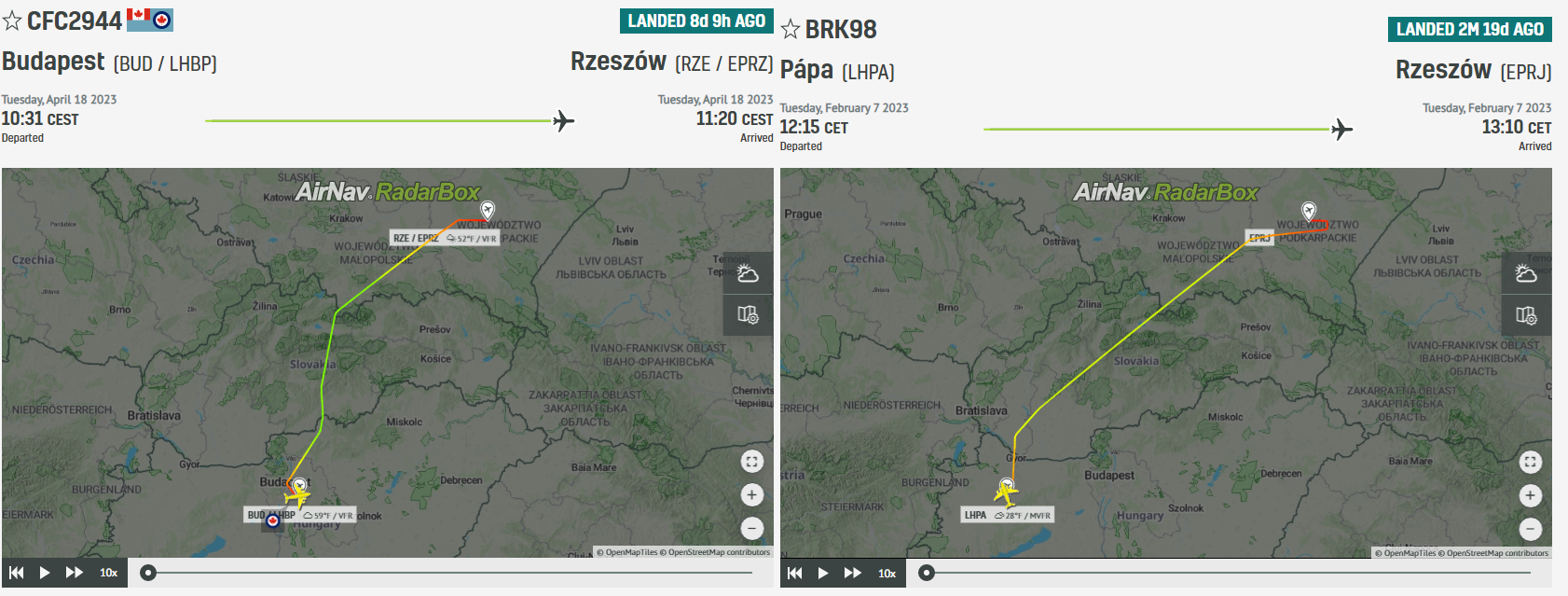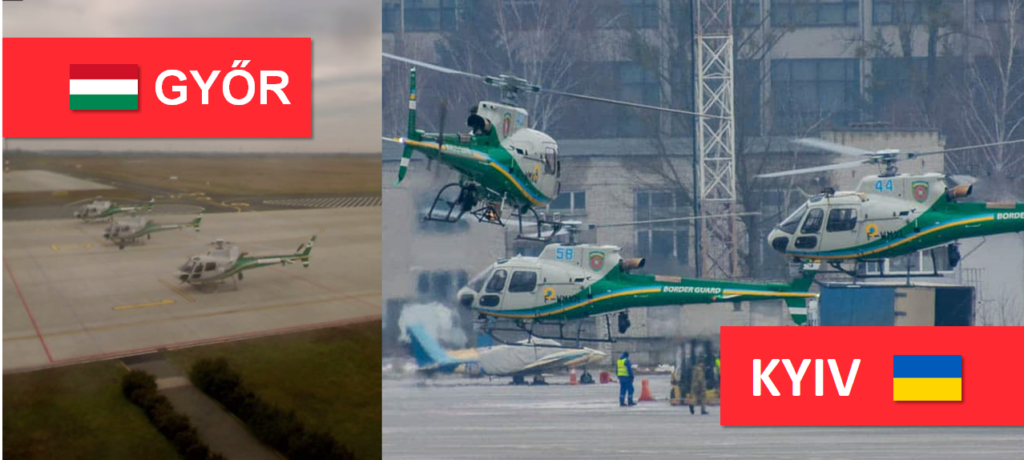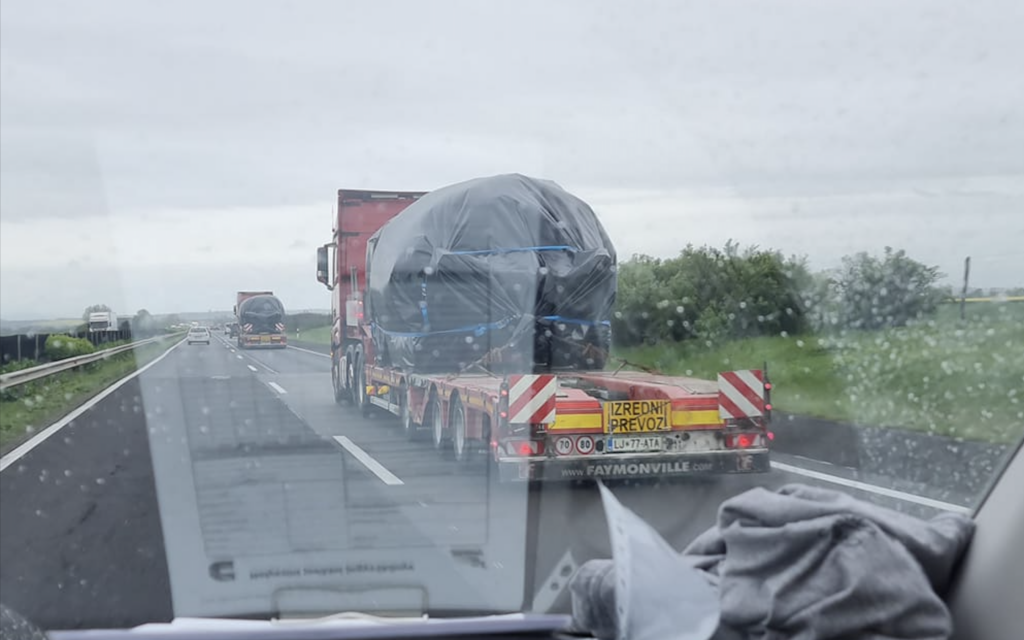The https://english.atlatszo.hu use cookies to track and profile customers such as action tags and pixel tracking on our website to assist our marketing. On our website we use technical, analytical, marketing and preference cookies. These are necessary for our site to work properly and to give us inforamation about how our site is used. See Cookies Policy
Video shows military helicopters handed over to the Ukrainians took off from Hungarian airport
French military helicopters were delivered to the Ukrainian border police via Győr-Pér airport in Western Hungary. This was revealed a few days after the ministry of defense categorically denied that they let Ukraine-bound military shipments through the Hungarian airspace.
Three H125M Fennec light military helicopters, bearing the insignia of the State Border Guard Service of Ukraine, arrive at Győr-Pér airport. After about 10 hours of waiting and maintenance, they fly to an unknown destination. These scenes can be seen on a video captured by a public web camera on 13 and 14 February.

A day earlier, the Ukrainian military news portal ‘Militarni’ published a report about the delivery of H125M helicopters to Ukraine. It was reported that in February, France will deliver 55 H125M helicopters to Ukraine, the first of which have already arrived, as can be seen on photos published on the site. The type and insignia of the helicopters are identical to those filmed at Győr airport.
Debunked denial of the Ministry of Defence
In mid-April, citing leaked US intelligence documents, Politico reported that while the Hungarian government is using pro-Russian, anti-Western rhetoric about the war in Ukraine, it is allowing allied states to use Hungarian airspace to transport arms to Ukraine. One of the documents cited by Politico outlines a plan for Ukrainian pilots to transport military helicopters donated by Croatia to Ukraine through Hungarian airspace.
In response to a question from Napi.hu, the Ministry of Defence called Politico’s report false, declaiming the “pro-peace” campaign slogan used in the elections. “Politico’s reports are wrong. Hungary has not allowed any helicopters to pass through to Ukraine (…) Hungary continues to send neither weapons nor ammunition nor soldiers to Ukraine and does not allow any military supplies to pass through to Ukraine. Only an immediate ceasefire and peace talks can end the war,” the ministry said in its reply.
However, the claim that no weapons or helicopters have passed through Hungary on their way to Ukraine is demonstrably false.
Media silence about Hungarian participation in Ukraine Defense Contact Group meetings – English
Hungarian government discusses arms transfers to Ukraine in Brussels under complete media silence in Hungary.
From Győr Airport to the Rzeszów airlift
Comparing the footage from Győr and the Ukrainian report from the helicopters, it is clear that the H125Ms with Ukrainian border guard markings were using the Hungarian airport. This was not the only time that similar helicopters stopped at Hungarian airports: on 2 and 28 February, helicopters from France stopped at Győr and Tököl airports. The aircraft’s transponder remained switched on, so their journey was recorded by the Radarbox flight tracking application.
The Radarbox flight tracking archive shows that the helicopters were heading from Hungary to Rzeszów airport near the Polish-Ukrainian border.
The small Rzeszów airport, formerly serving mainly domestic flights became the center of one of history’s largest military airlift operation since the Russian invasion of Ukraine last year. This is where much of the Western military aid to Ukraine passes through: military vehicles, ammunition, weapons, and other equipment are unloaded at Rzeszów-Jasionka airport, from where they are transported overland to Ukraine.
As early as spring 2022, there was evidence that weapons destined for the Ukrainians passed through Hungarian airspace: on 3 March, AFP published photos made on the Mihail Kogălniceanu airbase, showing Ukrainian Antonov Airlines An-124 cargo planes. The photos show the unloading of military equipment from the planes and the registration number of the aircraft. A comparison of the registration marks with the Radarbox archive shows that the cargo passed through Hungarian airspace.
Weapons shipments for Ukraine did pass through Hungary, despite the government’s contradicting claims – English
The Hungarian government claims that it does not allow the transit of arms shipments to Ukraine through Hungarian territory, either by land or air. However, since the war begun, military aircraft have entered Hungarian airspace more than 50 times to reach the Polish airport, which is the main hub for arms shipments to Ukraine.
In the following months, military cargo planes bound for Rzeszów were regular guests in Hungary: last year, between March and May alone, 49 military cargo planes from NATO member states (USA, Canada, Italy, Turkey) and 24 Ukrainian-registered aircraft passed through Hungarian airspace.
Planes also carried cargo from Budapest
The trend has continued this year: in the last three months, Radarbox has recorded 22 military transport missions involving Hungary. The military aircraft heading to Rzeszów have not only crossed Hungarian airspace, but also used Hungarian airports.

Route of military aircraft departing from Pápa and Budapest and landing in Rzeszów; source:radarbox.com
On 18 April this year, a Canadian Air Force aircraft flew unknown cargo to Rzeszów directly from the Budapest Airport. Earlier, on 7 February, a Boeing C-17 bearing Hungarian marking took off from the military airport in Pápa to deliver a cargo to Rzeszów. The aircraft is part of NATO’s Strategic Airlift Capability (SAC), a unit of Hungarian-registered aircraft operated by US pilots, based at the Pápa airbase.
Most cargo comes from Italy and Bulgaria
This year, the Italian Air Force and the Ukrainian Motor Sich cargo airline were the main users of Hungarian airspace on their way to Rzeszów. The latter was carrying cargo from Bulgaria. Bulgaria and Italy are two countries that provide military aid to Ukraine, while not disclosing details of the aid.
In January, Ukrainian Foreign Minister Dmitro Kuleba told Die Welt that after his visit to Sofia, the Bulgarian government agreed to allow “intermediaries” to sell arms and ammunition to Ukraine through NATO member states.
The operation “kept open air links through Poland and land transport routes through Romania and Hungary”.
Italy has also been secretive about arms transfers. All that is known is that Volodymyr Zelensky and PM Giorgia Meloni agreed on a sixth military aid package at the end of February, and Italy has started preparing the delivery. From mid-March onwards, Italian air force transport aircraft began to multiply in Hungary’s airspace.
The Ukrainian Border Guard Service, which received the helicopters via Hungary has been involved in fighting the Russian invasion and is currently under the command of the General Staff of the Ukrainian Armed Forces. In March 12, Ukrainian sources reported that a unit of the Border Guard Service was fighting Russia’s Wagner PMC in Bakhmut.
In February, the Ukrainian Ministry of Interior ordered the creation of a new so-called Offensive Guard: brigades tasked with supporting the regular army in the liberation of occupied territories. The creation of the Guard will involve bodies under the Ministry of Interior, including the Border Guard.
Road transport is also suspected
Slovenian military combat vehicles too may have been transported via the M3 motorway in Hungary for the Ukrainian army’s spring counter-offensive. On 26 April, Slovenia’s POP TV reported that the Slovenian army has handed over 20 Valuk armoured combat vehicles to Ukraine. A day earlier, what appears to be these vehicles were spotted on a Hungarian highway.
On April 25, a reader of the “Csehszlovák Kém” blog noticed and photographed a Slovenian military convoy on the M3 highway, near Galgaheviz, Hungary. The size and shape of the tarpaulin-covered vehicles is similar to the Slovenian Valuk. The person who took the photo said that he saw a total of 5-6 such trucks, escorted by a VW Transporter with Slovenian military plates, driven by men in uniform.
The M3 highway connects Hungary with Ukraine via the Beregsurány border crossing. The route of the convoy indicates that it could have been directly transported to Ukraine through the shared border with Hungary.
Written by Zalán Zubor and Botond Bőtös. The more detailed Hungarian versions of this story are available here and here.


